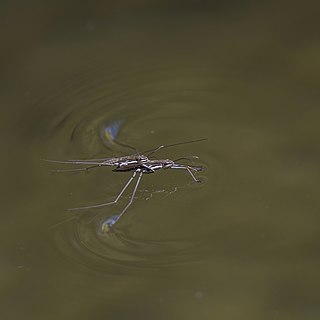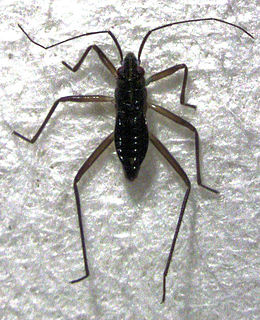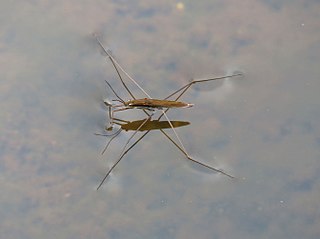Related Research Articles

The Gerridae are a family of insects in the order Hemiptera, commonly known as water striders, water skeeters, water scooters, water bugs, pond skaters, water skippers, Jesus bugs, or water skimmers. Consistent with the classification of the Gerridae as true bugs, gerrids have mouthparts evolved for piercing and sucking, and distinguish themselves by having the unusual ability to walk on water, making them pleuston (surface-living) animals. They are anatomically built to transfer their weight to be able to run on top of the water's surface. As a result, one could likely find water striders present in any pond, river, or lake. Over 1,700 species of gerrids have been described, 10% of them being marine.

Ranatra is a genus of slender predatory insects of the family Nepidae, known as water scorpions or water stick-insects. There are around 100 Ranatra species found in freshwater habitats around the world, both in warm and temperate regions, with the highest diversity in South America and Asia. Fewer are found elsewhere, but include several African, some in North America, three from Australia and three from the Palearctic, notably the relatively well-known European R. linearis.

Anthocoridae is a family of bugs, commonly called minute pirate bugs or flower bugs. Worldwide there are 500-600 species.

Thecophora is a genus of thick-headed fly from the family Conopidae.

Halobates or sea skaters are a genus with over 40 species of water striders. Most Halobates species are coastal and typically found in sheltered marine habitats, but five live on the surface of the open ocean and only occur near the coast when storms blow them ashore. These are the only known truly oceanic, offshore insects. They are found in tropical and subtropical marine habitats around the world, with a single species recorded in rivers a few kilometers upstream from the ocean. Halobates are generally very common.

Gerris is a bug genus in the family Gerridae.

Orthotylini is a tribe of plant bugs in the family Miridae. There are at least 50 genera and 540 described species in Orthotylini.

Mesovelia is a genus of water treaders in the family Mesoveliidae. There are more than 30 described species in Mesovelia.

Mesoveliidae is a family of water treaders in the order Hemiptera. There are about 16 genera and at least 50 described species in Mesoveliidae.

Limnoporus is a genus of water striders in the family Gerridae. There are six extant described species in Limnoporus.
Botocudo is a genus of dirt-colored seed bugs in the family Rhyparochromidae. There are at least 30 described species in Botocudo.

Rheumatobates is a genus of water striders in the family Gerridae. There are more than 30 described species in Rheumatobates.

Limnogonus is a genus of water striders in the family Gerridae. There are 28 described species in Limnogonus.

Hermatobates is a genus of wingless marine bugs placed as the sole genus in the family Hermatobatidae that are sometimes known as coral-treaders. They are quite rare and known only from coral reefs in the Indo-Pacific region. During low tide, they move over the water surface not unlike the more familiar water-striders around coral atolls and reefs and stay submerged in reef crevices during high tide.
References
- 1 2 "Halobates Report". Integrated Taxonomic Information System. Retrieved 2018-05-02.
- 1 2 "Browse Halobates". Catalogue of Life. Retrieved 2018-05-02.
- 1 2 "Halobates". GBIF. Retrieved 2018-05-02.
- 1 2 "Halobates Genus Information". BugGuide.net. Retrieved 2018-05-02.